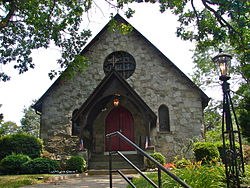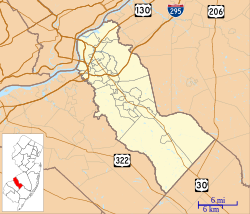St. John's Episcopal Church and Burying Ground
St. John's Episcopal Church and Burying Ground | |
 | |
| Nearest city | Runnemede, New Jersey |
|---|---|
| Coordinates | 39°49′56″N 75°3′48″W / 39.83222°N 75.06333°W |
| Area | 1.8 acres (0.73 ha) |
| Built | 1880-81 |
| Architect | Hewitt, George Watson |
| Architectural style | Gothic |
| NRHP reference No. | 80002475[1] |
| Added to NRHP | November 22, 1980 |
St. John's Episcopal Church and Burying Ground is a historic church in Runnemede, Camden County, New Jersey, United States. The congregation was founded in 1789 and the current church building was designed by George Watson Hewitt and consecrated by the Rt. Rev. John Scarborough on November 9, 1881.[2]
The church and burying ground were added to the National Register of Historic Places in 1980.
History[edit]
An extant record shows that an organizing meeting was held on November 14, 1789, and St. John's Church was officially established as part of the Protestant Episcopal Church of the United States of America. Available records also include a list of early contributors. A red cedar church was built in August, 1790. Local Revolutionary War hero Aaron Chew raised funds locally and from other soldiers from the war, including George Washington, James Madison, three signers of the Declaration of Independence, Frederick Muhlenberg, the first Speaker of the House of Representatives, a future Director of the U.S. Mint, several early state governors and U.S. congressmen.[2]
See also[edit]
References[edit]
- ^ "National Register Information System". National Register of Historic Places. National Park Service. March 13, 2009.
- ^ a b History of St. John's Church, accessed August 15, 2012.
External links[edit]
- Official website
- Find a Grave, lists all 714 known burials
- Episcopal church buildings in New Jersey
- Churches on the National Register of Historic Places in New Jersey
- Gothic Revival church buildings in New Jersey
- Churches completed in 1880
- 19th-century Episcopal church buildings
- Churches in Camden County, New Jersey
- National Register of Historic Places in Camden County, New Jersey
- Runnemede, New Jersey
- New Jersey Registered Historic Place stubs
- New Jersey church stubs



